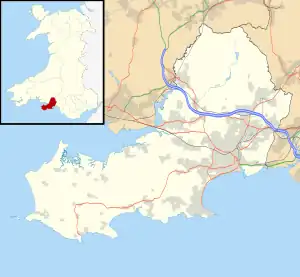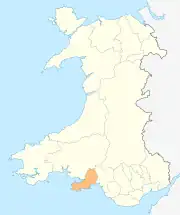Oystermouth
| |
|---|---|
 Shops in Oystermouth | |
 Oystermouth Location within Swansea | |
| Area | 2.01 km2 (0.78 sq mi) |
| Population | 4,160 (2011 census) |
| • Density | 2,070/km2 (5,400/sq mi) |
| Principal area | |
| Preserved county | |
| Country | Wales |
| Sovereign state | United Kingdom |
| Post town | SWANSEA |
| Postcode district | SA3 |
| Dialling code | 01792 |
| Police | South Wales |
| Fire | Mid and West Wales |
| Ambulance | Welsh |
| UK Parliament | |
| Senedd Cymru – Welsh Parliament | |
Oystermouth (Welsh: Ystumllwynarth) is a village (and former electoral ward) in the district of Mumbles, Swansea, Wales. It is part of the Mumbles community (civil parish).
Etymology

Samuel Lewis and Nicholas Carlisle both state that the original Welsh name was "Caer Tawy" (the Caer of the river Tawe).[1][2]
Thomas Morgan noted that the modern Welsh name, Ystumllwynarth was also found in early Medieval Welsh literature. Morgan derives this name from Ystum Lluarth which he defined as a "place of entrenchment on a hill" adding that the English name Oystermouth, is both a corruption of the existing Welsh name and a folk etymology connected to the locality's famous oyster beds.[3]
History
When the parish church was restored in 1860, fragments of Roman tessellated pavement were found in various parts of the churchyard. Roman coins were also found in the village in 1822 and 1837, all indicating that there had been a small settlement here in Roman times.[4]
The name "Caer Tawy" would indicate the existence of a Welsh-built fortification here predating the construction of both Norman castles at Oystermouth and Swansea.
The castle (see below) dates from the 12th century.
Description


The ward consists of suburban housing stretching from the northwest to the southeast. It is surrounded by the sea to the east and south. Two hills at Rams Tor and Mumbles Hill have little development. Mumbles Hill is now a protected nature reserve managed by the local council. The boundaries of Mumbles community and the Oystermouth ward are clearly defined. However, in the public mind, the separation between villages of Oystermouth and Mumbles is not clear. Local buses to the area are signed as Oystermouth, although most people from the area would say they are living in Mumbles.
Local beaches include the southern tip of Swansea Bay, Bracelet Bay and Limeslade Bay. From the Mumbles Head area, there are views towards Swansea, Port Talbot, and the hills of the South Wales Coalfield.
Oystermouth is the site of Oystermouth Cemetery.
Oystermouth was served by the Swansea and Mumbles Railway, one of the very earliest passenger rail services, along a shoreline railway used in the 19th century to transport limestone and coal. The long-disused (since the 1960s) route remains as a cycle/footpath.
Oystermouth parish is part of the Church in Wales. It has two churches: All Saints' Church, Oystermouth, and Norton Mission Church.[5] All Saints' Church dates back as far as the 12th-century, with 19th-century additions and has a Grade II heritage listing.[6]
Rowan Williams took the title Baron Williams of Oystermouth upon his retirement as Archbishop of Canterbury in December 2012.[7]
Oystermouth Castle
The 12th-century Oystermouth Castle is well preserved, in grounds with views over Swansea Bay. It was rebuilt in stone by the de Braoses, who were Lords of the Gower, and visited briefly by King Edward I of England in 1284. By the 16th century the castle was abandoned and in ruins.[8]
Electoral ward
Until 2022 the electoral ward consisted of some or all of the following areas: Oystermouth, the Mumbles, Thistleboon, Limeslade, in the parliamentary constituency of Gower. The ward was bounded by Newton to the west, West Cross to the north and Swansea Bay to the south and east. As of 2010 it had a population of around 4,100.[9]
Following a ward boundary review, the Oystermouth and Newton wards were combined to create a new ward of Mumbles, represented by three county councillors.[10]
2012 local council election
For the 2012 local council elections, electorate turnout for Oystermouth was 37.23%. The election results were:
| Candidate | Party | Votes | Status |
|---|---|---|---|
| Anthony Colburn | Conservative | 500 | Conservative hold |
| Pam Erasmus | Labour | 444 | |
| Dorian Davies | Independent | 311 |
Tony Colburn was re-elected in May 2012 with a vote of 500, on a 37.2% turnout.
The ward had been represented continuously by the Conservative Party since 1995.[11]
See also
References
- ↑ Lewis, Samuel (1849). A Topographical Dictionary of Wales. London. pp. 271–274. Retrieved 5 March 2023.
- ↑ Carlisle, Nicholas (1811). A topographical dictionary of ... Wales, a continuation of the topography of the United kindom of Great Britain and Ireland. Oxford: Oxford University Press. Retrieved 5 March 2023.
- ↑ Morgan, Thomas (1912). The Place-Names of Wales. Dalcassian Publishing Company. Retrieved 5 March 2023.
- ↑ One or more of the preceding sentences incorporates text from a publication now in the public domain: Chisholm, Hugh, ed. (1911). "Oystermouth". Encyclopædia Britannica. Vol. 20 (11th ed.). Cambridge University Press. p. 429.
- ↑ "Oystermouth Parish".
- ↑ Church of All Saints, Oystermouth, Mumbles, British Listed Buildings. Retrieved 21 July 2018.
- ↑ "Peerage for the Lord Archbishop of Canterbury". Number 10.
- ↑ "Oystermouth Castle". Castles of Wales. Retrieved 21 July 2018.
- ↑ "Oystermouth ward profile" (PDF). Swansea ward profiles. Archived from the original (PDF) on 5 September 2012. Retrieved 26 January 2013.
- ↑ Richard Youle (30 June 2021). "Swansea is to have three more councillors next year as some boundaries change". Wales Online. Retrieved 22 May 2022.
- ↑ Swansea Welsh Unitary Council Election Results 1995-2012, The Elections Centre. Retrieved 21 July 2018.
External links
![]() Media related to Oystermouth at Wikimedia Commons
Media related to Oystermouth at Wikimedia Commons
